Laptop Mag Verdict
The MSI GE73VR 7RF Raider Pro is a powerful gaming laptop with sleek racing stripes and loud speakers, but the display could be brighter and the keyboard isn't punchy enough.
Pros
- +
Slick design
- +
Strong performance
- +
Powerful speakers
Cons
- -
Display is dimmer than average
- -
Lackluster keyboard and mouse
Why you can trust Laptop Mag
Racing stripes don't make everything go faster, but they can make them look cooler. The 17-inch MSI GE73VR 7RF Raider Pro ($1,949 to start, $2.399 as tested) has a fresh design that stands out. It also packs some powerful speakers, and, thanks to a GTX 1070 GPU with 8GB of VRAM, smooth frame rates for intensive games at high settings. What brings the Raider Pro down are its dimmer-than-average display and its keyboard and mouse, which aren't up to par with other gaming laptops.
Design
I really like that MSI's doing something a little different with the Raider. It's still the black and red that shouts "look at me, I play games!" but there are a few new flourishes on the machine that I find refreshing. The lid is faux-brushed aluminum, but instead of being totally flat, it has a small hump where the silver MSI logo and red dragon shield are more pronounced. On each side of the hump are red, angular patterns.
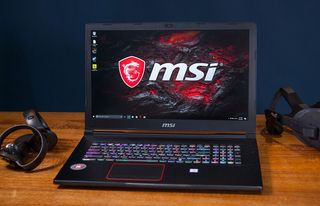
When you open the laptop, it's largely the same. The 17.3-inch, 1080p display is surrounded by a thick bezel, and the rainbow-backlit sRGB keyboard with a number pad rests on an aluminum deck.
At 6.3 pounds and 16.4 x 11.2 x 1.1 inches, the Raider is significantly lighter than competing 17-inch gaming notebooks. The Alienware 17 R4 is 9.6 pounds (16.7 x 13.1 x 1.2 inches), the Asus ROG G752VS OC Edition is 10 pounds (16.4 x 12.7 x 1.9 inches) and the Lenovo Legion Y920 is 10.1 pounds (16.8 x 12.1 x 1.4 inches).
The sides of the Raider are lined with ports for peripherals and extra storage. The left side has an Ethernet jack, an HDMI output, a MiniDisplay Port, a USB 3.0 port, a USB Type-C port, a headphone jack and a microphone jack. The right sidesports an SD card reader and a pair of USB 3.0 ports. Unfortunately, there's no Thunderbolt 3 port.
All three USB 3.0 ports aren't the usual blue. Instead, they glow red with some LEDs. It looks cool and is great for finding the ports during late-night gaming, but you can turn them off in Dragon Center if you want to save your battery life.
Display
The 17.3-inch, 1080p display on the Raider is extremely colorful, but not as bright as competitors'. It's far from unusably dim, though, and when I watched the trailer for Thor: Ragnarok, Hela's emerald-green cape was the perfect shade, and Loki's blue eyes shined bright during a mischievous smile. Some colors, like Thor's bright-red cape, appeared oversaturated. When I played Star Wars Battlefront, I could make out small details, like rocks and sticks in the muddy forests of Endor, and the fabric in Emperor Palpatine's cape waved behind him as he hovered over the surface. But the blacks were a bit too dark, making it hard to see the creases in the cape.
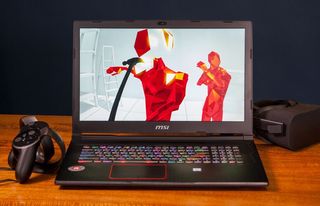
The Raider's panel covers an incredible 185 percent of the sRGB color gamut, far more colorful than the desktop-replacement average of 127 percent, as well as the Legion (119 percent), the Alienware (113 percent) and the ROG (112 percent).
Unfortunately, it's dimmer than all of those machines. On our light meter, the Raider's screen measured an average 276.2 nits of brightness, falling below the 289-nit average, as well as the Alienware (340 nits), Legion (362 nits) and ROG (476 nits).
Keyboard and Touchpad
MSI's partnership with SteelSeries has generally been a winning combination. But even with 1.9 millimeters of travel and 76 grams of required force to press, the Raider has keys that feel loose and don't have any punch. I wish they resisted me a little more for that clicky feeling I love so much. On the 10fastfingers.com typing test, I reached 102 words per minute, below my usual 107 wpm, with an error rate of 4 percent (double my usual 2 percent).
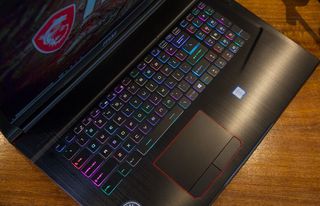
The SteelSeries Engine 3 program has some tricks up its sleeve, including per-key RGB lighting, a number of preset effects for the keyboard and, my favorite, lighting up all of the available key combinations when you hit the function key.
The 4.1 x 2.4-inch keyboard is comfortable to navigate with, but its Synaptics drivers allow only the most basic gestures, like pinch-to-zoom and scrolls. Want to use three fingers to call up Cortana or swipe all of your open windows to the taskbar? Too bad -- this touchpad doesn't support that.
Audio
The Raider's two speakers and two woofers pack one heck of a punch. When I listened to Ellie Goulding's "Burn," our midsize conference room was filled to the brim with clear vocals, deep bass and blasting synthesizers and drums.
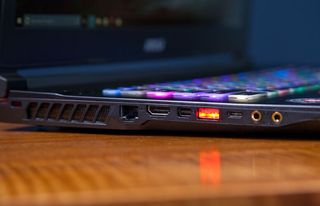
With the preinstalled Nahimic Audio 2+ software, I was able to adjust the reverb, which made it feel as if I were at a live show. There are a number of presets in the software for different game modes, as well as music and film, but I found that the default music mode is great.
When I played Star Wars Battlefront, it sounded as if I was in the battle, with blasters ringing out loudly in our lab, and the detailed crackling of Force lightning projecting out from in front of me.
Gaming, Graphics and VR
The Raider's GTX 1070 GPU with 8GB of VRAM should tackle any game you throw at it, and will also power immersive VR experiences. I played Star Wars Battlefront at 1080p on ultra settings. As Emperor Palpatine, I stormed through Endor, leading a pack of stormtroopers and shooting Force lightning at rebel soldiers at a smooth 135 frames per second (fps).

MSI's rig played Hitman (1080p, Ultra) at 99 fps, breezing past the desktop-replacement average of 82 fps and the ROG's 91 fps, but falling behind the Legion and Alienware at 107 fps and 110 fps, respectively.
MORE: Most Anticipated Games
On the Rise of the Tomb Raider benchmark (1080p, Very High) it achieved an average of 55 fps, beating the average (52 fps) and tying the ROG. Again, the Legion (59 fps) and the Alienware (62 fps) were faster.
If you have an HTC Vive or Oculus Rift, the Raider will have no issue powering VR games. It earned a score of 10.9 (out of a maximum 11) on the SteamVR performance test, falling behind only the Alienware and its perfect score. The average is 9.4, the ROG hit 10.4 and the Legion notched a 10.6.
Performance
Between the Raider's 2.8-GHZ Intel Core i7-7700HQ CPU, 32GB of RAM, 512GB M.2 SATA SSD and 1TB, 7,200-rpm HDD, it's no surprise that the Raider can handle everyday tasks with ease. I had 30 tabs open in Google Chrome, one of which was streaming a 1080p episode of Last Week Tonight, without the laptop even breaking a sweat.
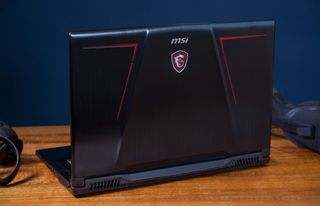
The Raider earned a score of 14,232 on the Geekbench 4 overall performance, breezing past the desktop-replacement average (12,898) and surpassinh the Legion (14,051, i7-7820HK), the Alienware (14,154, i7-7820HK) and the ROG (14,717, i7-7820HK).
MORE: Our Favorite Gaming Keyboards
It took the Raider 28 seconds to copy 4.97GB of files, a rate of 181.8 MBps. The desktop-replacement average is a far speedier 510 MBps, and both the Legion (636.2 MBps) and the ROG (727 MBps) were even faster than that. The Alienware was also quicker than the Raider, at 292MBps.
The Raider completed our OpenOffice spreadsheet test, pairing 20,000 names and addresses, in 3 minutes and 20 seconds. That comes out just ahead of the average (3:25), and is faster than the Legion (3:48). The ROG (2:61) and the Alienware (1:47), however, were both superior.
Battery Life
Unsurprisingly, the Raider is a real battery hog. It lasted 3 hours and 57 minutes on the Laptop Mag Battery Test, which browses the web continuously over Wi-Fi. The desktop-replacement average is longer at 4:14, but other gaming notebooks fared even worse. The ROG endured for 3:53, the Legion ran for 3:02 and the Alienware petered out after 2:46.
Heat
The Raider doesn't get too hot under the collar during everyday use. After streaming 15 minutes of HD video from YouTube, the touchpad measured 77 degrees Fahrenheit, the center of the keyboard reached 87 degrees and the bottom hit 92 degrees. All of these numbers fall within our 95-degree comfort threshold.

After I played Star Wars Battlefront, it got a bit steamier. The touchpad didn't change temperature, but the keyboard reached 103 degrees and the laptop's underside climbed to a toasty 116 degrees..
Webcam
Get an external webcam for Twitch streaming, because the one on the Raider just won't do.

The 720p shooter struggles, especially in low light, though it manages to catch a decent amount of detail. Where my hair was visible in a shot in our office, I could make out individual strands, but my face was covered in shadows.
Software and Warranty
MSI packed the Raider with gaming software, but there's also a bit of bloat. Dragon Center, as usual, is a standout, with its myriad of system monitoring, customization and performance options.

Additionally, Killer Control Center lets you decide which applications get priority access to your network, and MSI True Color offers pre-calibrated color options for gaming, designing, office work and night computer use. For streaming, TriDef Smartcam lets you replace the background, and XSplit Gamecaster allows you to stream to multiple sites at once.
Most of the bloat consists of apps baked into every copy of Windows 10, including Minecraft: Windows 10 Edition; Bubble Witch 3 Saga; Keeper Password Manager; March of Empires: War of Lords; and Twitter.
MSI sells the GE73VR 7RF Raider Pro with a one-year warranty. See how it fared in our Tech Support Showdown and Best and Worst Gaming Laptop Brands ranking.
Configurations
We reviewed the MSI GE73VR Raider Pro, a $2,399 machine with 2.8-GHZ Intel Core i7-7700HQ CPU, an Nvidia GeForce GTX 1070 GPU with 8GB of VRAM, 32GB of RAM, a 512GB M.2 SATA SSD and 1TB, 7,200-rpm HDD.
A $1,949 model, simply called the MSI GE73VR 7RE Raider (no Pro), comes with an Nvidia GeForce GTX 1060 with 6GB of VRAM.
Bottom Line
The MSI GE73VR Raider Pro is a hardy gaming machine that offers strong performance, a slick new design and speakers loud enough to fill a room. But its display, while colorful, is dimmer than the competition, and its keyboard doesn't offer the tactile feel I like for gaming.
The high-end Alienware R4 ($2,599 as tested) is our top pick for a 17-inch gaming laptop with its bright and vivid display, incredible performance (thanks to a GTX 1080), graphics amp support and a ton of ports (don't cheap out and go for a lower-end Alienware, though, which we found had a slow hard drive). If you want to stick with a GTX 1070, the $2,499 Asus ROG G752VS OC Edition overclocked card does wonders, and it also has a bright display.
The Raider Pro, though, offers some of the best sound I've heard on a gaming notebook in a while, and if looks matter, you'll love its racing stripes.
Credit: Shaun Lucas/Laptop Mag
MSI GE73VR 7RF Raider Specs
| Bluetooth | Bluetooth 4.1 |
| Brand | MSI |
| CPU | 2.8-GHz Intel Core i7-7700HQ |
| Card Slots | SD memory reader |
| Company Website | msi.com |
| Display Size | 17.3 |
| Graphics Card | Nvidia GeForce GTX 1070 GPU / 8GB |
| Hard Drive Size | 512GB SSD |
| Hard Drive Type | M.2 SATA SSD |
| Highest Available Resolution | 1920 x 1080 |
| Native Resolution | 1920x1080 |
| Operating System | Windows 10 Pro |
| Ports (excluding USB) | Mini DisplayPort, SD card slot, USB 3.0, Ethernet, USB Type-C, HDMI, Headphone, Microphone |
| RAM | 32GB |
| Secondary Hard Drive Size | 1TB |
| Secondary Hard Drive Speed | 7,200rpm |
| Size | 16.49 x 11.22 x 1.12 |
| Touchpad Size | 4.1 x 2.4 inches |
| USB Ports | 4 |
| Video Memory | 8GB |
| Warranty/Support | 1-year limited warranty |
| Weight | 6.3 pounds |
| Wi-Fi | 802.11ac |
| Wi-Fi Model | Killer N1435 2x2 ac |
